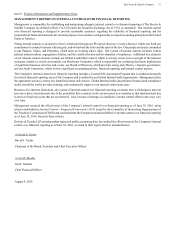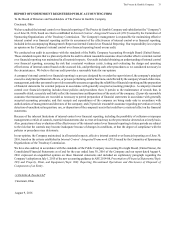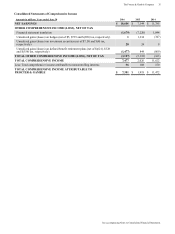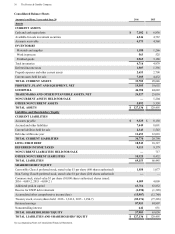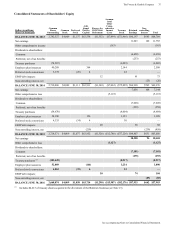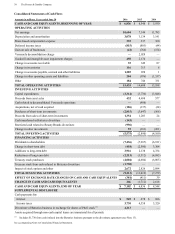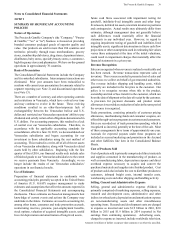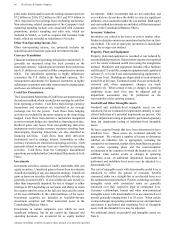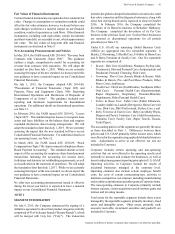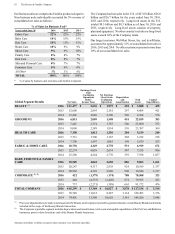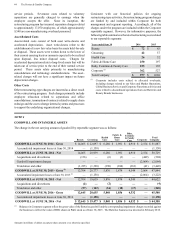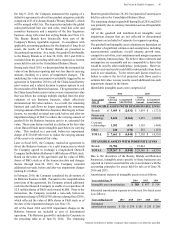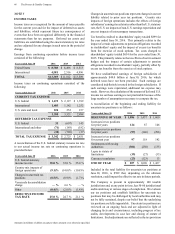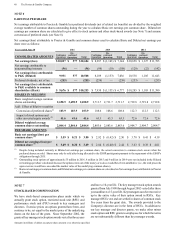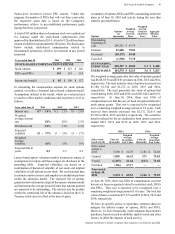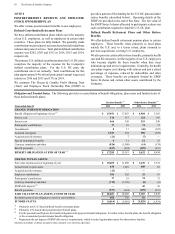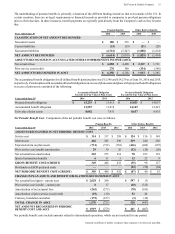Proctor and Gamble 2016 Annual Report Download - page 55
Download and view the complete annual report
Please find page 55 of the 2016 Proctor and Gamble annual report below. You can navigate through the pages in the report by either clicking on the pages listed below, or by using the keyword search tool below to find specific information within the annual report.The Procter & Gamble Company 41
Amounts in millions of dollars except per share amounts or as otherwise specified.
Fair Values of Financial Instruments
Certain financial instruments are required to be recorded at fair
value. Changes in assumptions or estimation methods could
affect the fair value estimates; however, we do not believe any
such changes would have a material impact on our financial
condition, results of operations or cash flows. Other financial
instruments, including cash equivalents, certain investments
and short-term debt, are recorded at cost, which approximates
fair value. The fair values of long-term debt and financial
instruments are disclosed in Note 9.
New Accounting Pronouncements and Policies
In May 2014, the FASB issued ASU 2014-09, “Revenue from
Contracts with Customers (Topic 606)”. This guidance
outlines a single, comprehensive model for accounting for
revenue from contracts with customers. We will adopt the
standard no later than July 1, 2018. While we are currently
assessing the impact of the new standard, we do not expect this
new guidance to have a material impact on our Consolidated
Financial Statements.
On July 1, 2015, the Company adopted ASU 2014-08,
"Presentation of Financial Statements (Topic 205) and
Property, Plant, and Equipment (Topic 360): Reporting
Discontinued Operations and Disclosures of Disposals of
Components of an Entity". The guidance included new
reporting and disclosure requirements for discontinued
operations. For additional details on discontinued operations,
see Note 13.
In February 2016, the FASB issued ASU 2016-02, “Leases
(Topic 842)”. The standard requires lessees to recognize lease
assets and lease liabilities on the balance sheet and requires
expanded disclosures about leasing arrangements. We will
adopt the standard no later than July 1, 2019. We are currently
assessing the impact that the new standard will have on our
Consolidated Financial Statements. For additional details on
our operating leases, see Note 12.
In March 2016, the FASB issued ASU 2016-09, “Stock
Compensation (Topic 718): Improvements to Employee Share-
Based Payment Accounting”. The standard amends several
aspects of the accounting for employee share-based payment
transactions including the accounting for income taxes,
forfeitures and statutory tax withholding requirements, as well
as classification in the statement of cash flows. We will adopt
the standard no later than July 1, 2017. While we are currently
assessing the impact of the new standard, we do not expect the
new guidance to have a material impact on our Consolidated
Financial Statements.
No other new accounting pronouncement issued or effective
during the fiscal year had or is expected to have a material
impact on our Consolidated Financial Statements.
NOTE 2
SEGMENT INFORMATION
On July 9, 2015, the Company announced the signing of a
definitive agreement to divest four product categories, initially
comprised of 43 of its beauty brands (“Beauty Brands”), which
will be merged with Coty Inc. ("Coty"). The transaction
includes the global salon professional hair care and color, retail
haircolor,cosmeticsandfinefragrancebusinesses,alongwith
select hair styling brands and is expected to close in October
2016. In February 2016, the Company completed the
divestiture of its Batteries business to Berkshire Hathaway.
The Company completed the divestiture of its Pet Care
business in the previous fiscal year. Each of these businesses
are reported as discontinued operations for all periods
presented (see Note 13).
Under U.S. GAAP, our remaining Global Business Units
(GBUs) are aggregated into five reportable segments: 1)
Beauty, 2) Grooming, 3) Health Care, 4) Fabric & Home Care
and 5) Baby, Feminine & Family Care. Our five reportable
segments are comprised of:
•Beauty: Hair Care (Conditioner, Shampoo, Styling Aids,
Treatments); Skin and Personal Care (Antiperspirant and
Deodorant, Personal Cleansing, Skin Care);
• Grooming: Shave Care (Female Blades & Razors, Male
Blades & Razors, Pre- and Post-Shave Products, Other
Shave Care); Appliances;
• Health Care: Oral Care (Toothbrushes, Toothpaste, Other
Oral Care); Personal Health Care (Gastrointestinal,
Rapid Diagnostics, Respiratory, Vitamins/Minerals/
Supplements, Other Personal Health Care);
• Fabric & Home Care: Fabric Care (Fabric Enhancers,
Laundry Additives, Laundry Detergents); Home Care (Air
Care, Dish Care, P&G Professional, Surface Care ); and
• Baby, Feminine & Family Care: Baby Care (Baby Wipes,
Diapers and Pants); Feminine Care (Adult Incontinence,
Feminine Care); Family Care (Paper Towels, Tissues,
Toilet Paper).
The accounting policies of the segments are generally the same
as those described in Note 1. Differences between these
policies and U.S. GAAP primarily reflect income taxes, which
are reflected in the segments using applicable blended statutory
rates. Adjustments to arrive at our effective tax rate are
included in Corporate.
Corporate includes certain operating and non-operating
activities that are not reflected in the operating results used
internally to measure and evaluate the businesses, as well as
items to adjust management reporting principles to U.S. GAAP.
Operating activities in Corporate include the results of
incidental businesses managed at the corporate level.
Operating elements also include certain employee benefit
costs, the costs of certain restructuring-type activities to
maintain a competitive cost structure, including manufacturing
and workforce optimization and other general Corporate items.
The non-operating elements in Corporate primarily include
interest expense, certain acquisition and divestiture gains and
interest and investing income.
Total assets for the reportable segments include those assets
managed by the reportable segment, primarily inventory, fixed
assets and intangible assets. Other assets, primarily cash,
accounts receivable, investment securities and goodwill, are
included in Corporate.


